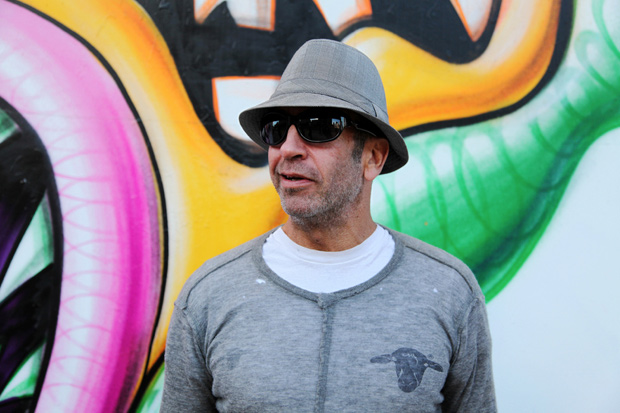
Thursdays at the Huffington Post, Rana Florida, CEO of The Creative Class Group, will answer readers' questions about how they can optimize their lives. She will also feature conversations with successful entrepreneurs and thought leaders about how they manage their businesses, relationships, careers, and more. Send your questions about work, life, or relationships to rana@creativeclass.com.
Earlier this year American popular culture artist Kenny Scharf debuted on The Simpsons; he has also been commissioned for special projects ranging from Mercedes, Absolut, Kiehl's and Barbie to the Brooklyn Children's Hospital.
Scharf made quite a splash in the New York art scene in the '80s with his roommate and collaborator Keith Haring. "Nearly 30 years ago," wrote the The New York Times, "Mr. Scharf's cartoony do-it-yourself environments were a retort to a grimly professional art world -- and a whole lot of fun. They still are."
Art is not just his passion but his quest; he sees it as a way to change his own and others' thought processes -- to raise consciousness and enhance the quality of everyday life. His colorful and vibrant works can be found in top museums and galleries around the world, including the Whitney Museum of American Art, New York; the Sogetsu Art Museum, Tokyo; MOCA Los Angeles; the Garage Center for Contemporary Culture, Moscow; the Stedelijk Museum, Amsterdam; the Fraser Gallery in Los Angeles; the Paul Kasmin Gallery, New York; and the Gagosian Gallery, Beverly Hills.
But Scharf is still a strong believer in breaking down museum walls; he invites everyone to connect to his work -- which includes sculpture, paintings, and performance. You might have seen some of his graffiti art in a gritty neighborhood of Miami, where he was commissioned by Deitch Projects to participate in the "Wynwood Walls" Outdoor Mural Project for Art Basel Miami. If you missed him on The Simpsons, perhaps you've spotted some of his work on the Cartoon Network while you were flipping through the channels; he also designed a custom bike for Lance Armstrong, which he rode in the Tour de France.
I've interviewed architects, CEO's, fashion designers, authors, entrepreneurs, techies, politicians and chefs on business, leadership and creativity. After having dinner recently with Scharf and learning more about his views on cities, scenes, and creativity, I thought it would be fun to ask one of the world's most famous graffiti artists for his perspective on business. Short, sweet, straight-to-the-point, and sometimes a little Zen-like, here are Scharf's takes on collaboration, failure, and compromise.

Photo credit: http://theballast.wordpress.com/
Q. What was your first job and what lessons did you take away?
A. I worked for a caterer for Sephardic bar mitzvahs and weddings. It was fun working with my friends but my feet would ache from standing so much.
Q. Where do you find your motivation?
A. From within and from healthy competition.
Q. Do you think of work as work or something you enjoy doing?
A. I've got a great job I love, so yes to both.
Q. Do you work better individually or in teams? Why?
A. Each has its merits and downsides. I usually work alone but that can get lonely, so working in groups is refreshing sometimes.
Q. How do you deal with challenges or obstacles in reaching your goals?
A. I try to make the journey as great as the goal so bumps and roadblocks are usually part of the process. There is always another twist or turn that can help free the blocks.
Q. Does the city you live in impact your success? How or why?
A. I live in Los Angeles and New York and both cities offer different ups and downs. I made my name in New York and if I can make it there I'll make it anywhere!
Q. How do you ensure a product or art collection doesn't turn into a fad or trend? How do you do something for the long run?
A. Be authentic and true and give it your all. Persevere to stand the test of time.
Q. How do you handle criticism or failure?
A. There's no such thing as failure; it's all part of the learning process. Criticism is only good when it's observant. I often read critics saying things I agree with, only I think the artist is good and I'm assuming the critic thinks otherwise.
Q. How do you take your work across other mediums?
A. It's all the same, just different tools; the message is usually the same.
Q. Do you ever compromise your vision for clients or collaborators?
A. Compromise can be healthy in a give and take situation, but never compromise your integrity or the quality of the outcome.
